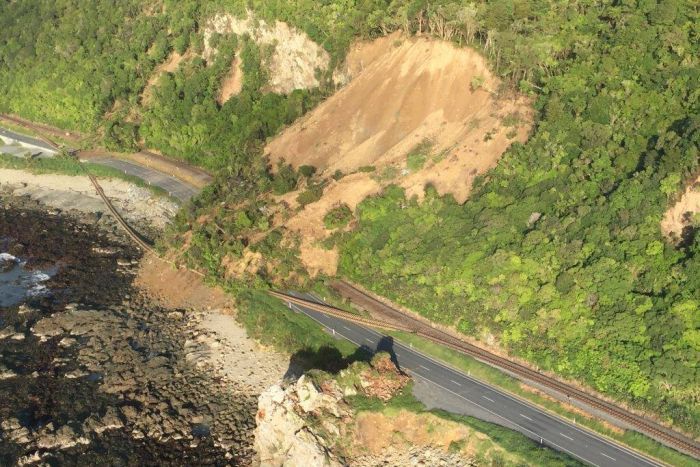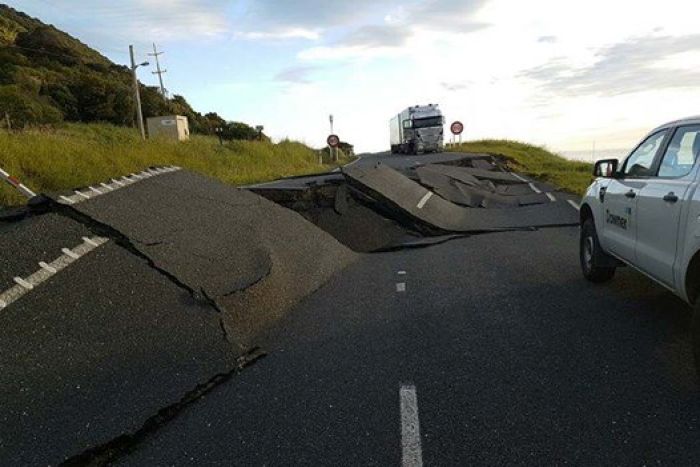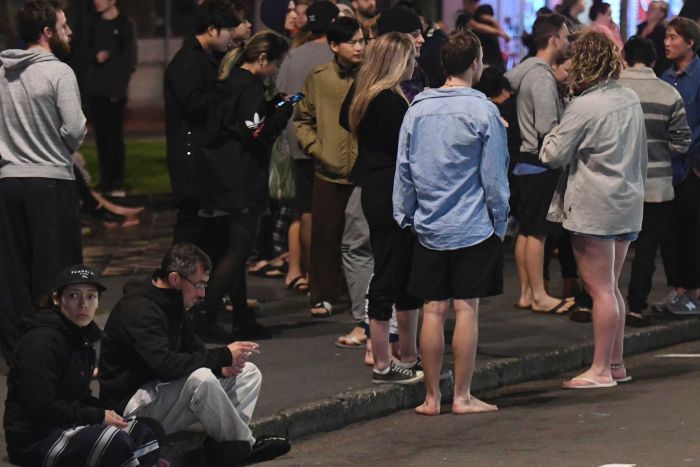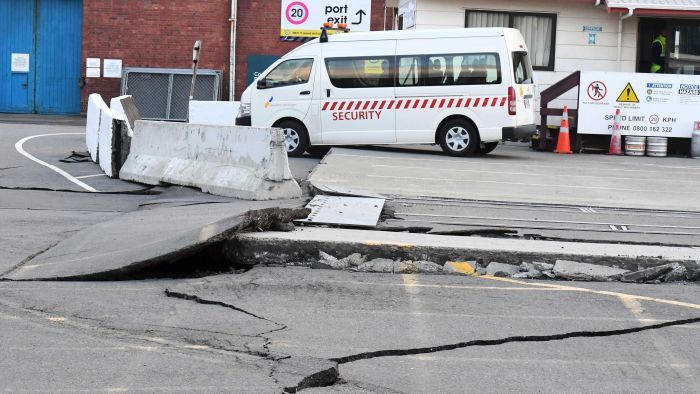New Zealand earthquake: Tsunami hits after magnitude-7.8 quake strikes near Christchurch
Updated
A powerful earthquake and hundreds of strong aftershocks have rocked New Zealand, killing at least two people and prompting a tsunami warning that sent thousands fleeing to higher ground.
Key points:
- Magnitude-7.8 quake struck 90 kilometres north-east of Christchurch
- Two people found dead in coastal town of Kaikoura and Mt Lyford ski resort
- Road, rail links close after land slippages and cracking
With communications cut off, emergency response teams were flying by helicopter to the region at the epicentre of the magnitude-7.8 quake, about 90 kilometres north-east of Christchurch in the South Island, amid reports of injuries and collapsed buildings.
A second earthquake, initially measured as magnitude 6.8 but revised down to 6.2, struck the South Island hours afterward, but there were no reports of deaths or injuries.
Hours after the initial quake, Marlborough District Council warned residents to flee to high ground immediately after a Slip Dam on the Clarence River breached, sending a large wall of water downstream.
Two people were killed in the quake, with Prime Minister John Key telling reporters authorities had no reason to believe the death toll would rise.
"On the very best information we have at the moment, we think it's only likely to be two," Mr Key said.
"But of course there are isolated parts of the country which we don't have perfect eyes on, so we can't be 100 per cent sure."
New Zealand's Geonet measured the first quake at magnitude 7.5, while the US Geological Survey put it at 7.8.
Mr Key said officials had decided not to declare a national emergency because the nation's regions were able to adequately cope with the situation.
Police said one person died in the small coastal town of Kaikoura and another in Mt Lyford, a nearby ski resort.
There were also reports that several people had suffered minor injuries in Kaikoura, police spokeswoman Rachel Purdom said.
Mr Key was travelling to Kaikoura by helicopter on Monday afternoon.
The Prime Minister said waves of about 2 metres hit the coast but the tsunami threat had since been downgraded to coastal warnings.
Marlborough District Council said in a statement that police were working to rescue travellers stranded to the immediate north and south of Kaikoura.
"It's understood the occupants of at least half a dozen campervans to the north of Kaikoura are due to be airlifted to the Ward Welfare Centre," the statement said.
"Those stranded to the south of the town will be airlifted further south."
The Marlborough District's Civil Defence said it would be daybreak before there was a clearer picture of the situation and helicopters would do a sweep of coastal areas as work begins to assess the damage.
Evacuation centres were set up at locations across the affected area.
 Photo:
Local residents Chris and Viv Young look at damage caused by the earthquake, along a highway near the town of Ward, south of Blenheim on New Zealand's South Island. (Reuters: Anthony Phelps)
Photo:
Local residents Chris and Viv Young look at damage caused by the earthquake, along a highway near the town of Ward, south of Blenheim on New Zealand's South Island. (Reuters: Anthony Phelps)
Roads, railways damaged after quake
The earthquake caused major damage to infrastructure.
Road and rail links in the north of the island were closed after land slippages and cracking.
Regional Civil Defence controller Richard McNamara said one of the biggest problems would be rebuilding.
"It's our opinion that they're going to be out for quite some time. You only have to look at photos in the media and on social media to tell you that there is a huge amount of damage on state highway one and the main trunk line," he said.
Power was out and phone lines down in many parts of the country.
The quake temporarily knocked out New Zealand's emergency call number, 111, police reported.
 Photo:
Train tracks on State Highway One near Kaikoura are pushed out to sea after a major landslip. (Supplied: Marlborough District Council)
Photo:
Train tracks on State Highway One near Kaikoura are pushed out to sea after a major landslip. (Supplied: Marlborough District Council)
The powerful quake hit just after midnight (local time), with strong jolts causing some damage to buildings more than 200 kilometres away in the capital, Wellington.
Soon after the quake, Anna Kaiser, a seismologist at GNS Science, said a tidal signal or surge of up to 1 metre had already been recorded in the North Canterbury region of the South Island.
"That's reasonably significant, so people should take this seriously," she told Radio New Zealand.
The Pacific Tsunami Warning Centre said there was no immediate danger of a broader Pacific-wide tsunami from the quake.
Prime Minister Malcolm Turnbull told Channel 7 on Monday morning that he had called his New Zealand counterpart to offer assistance.
"I spoke with John Key a few moments ago. I assured him of absolute solidarity and support from Australia," he said.
"He knows that we support them when it comes to emergencies and natural disasters."
Effects felt as far as Wellington
 Photo:
The quake severely damaged some roads, making access to affected areas difficult. (Twitter: Marlborough Emergency)
Photo:
The quake severely damaged some roads, making access to affected areas difficult. (Twitter: Marlborough Emergency)
In Wellington, 214 kilometres north of the quake's epicentre, power was knocked out in some places, with windows smashed and chimneys damaged.
Authorities in Wellington were urging people who work in the city's central business district to stay home on Monday.
Officials said some large buildings were showing signs of structural stress, and the quake would likely have caused a mess in some buildings.
The city's suburban rail network was shut while crews checked tracks, bridges and tunnels.
Radio New Zealand said the Wellington City Council had received multiple reports of significant damage.
Local media reported landslips and extensive damage to roads.
Earthquake 'scarier than normal'
 Photo:
People evacuated from buildings stand on a street in Wellington, after the earthquake shook the New Zealand capital. (AP: Ross Setford/SNPA)
Photo:
People evacuated from buildings stand on a street in Wellington, after the earthquake shook the New Zealand capital. (AP: Ross Setford/SNPA)
ABC journalist Tom Maddocks was staying in Christchurch at the time of the quake and was evacuated from a hostel in the area.
He said the coastal suburb of New Brighton, some 10 kilometres from Christchurch, had been swiftly evacuated.
Chris Hill, a fire officer in Cheviot, a coastal town near the quake's epicentre, said officials had gone door-to-door evacuating residents.
"Everyone seems OK here. There's a lot of debris in houses, but at this stage it doesn't look like anything too bad has happened," he told Radio New Zealand.
Australian journalist Gemma Snowdon, who is living just north of Christchurch, told the ABC the tremor woke her from her sleep.
"I ran outside with my housemates and we quickly realised what was going on and the ground just shook and shook and shook and it seemed never-ending," she said.
Snowdon said the situation was "scarier than normal".
"I have been hearing sirens and alarms going off throughout the city. I think everyone is a bit shaken up by this," she said.
"[Earthquakes] are a common occurrence but this one was particularly long and protracted."
The quake struck at a relatively shallow depth of 10 kilometres. Earthquakes tend to be more strongly felt on the surface when they are shallow.
New Zealand sits on the "Ring of Fire", an arc of seismic faults around the Pacific Ocean where earthquakes are common.
ABC/wires
Topics: earthquake, disasters-and-accidents, new-zealand
First posted











